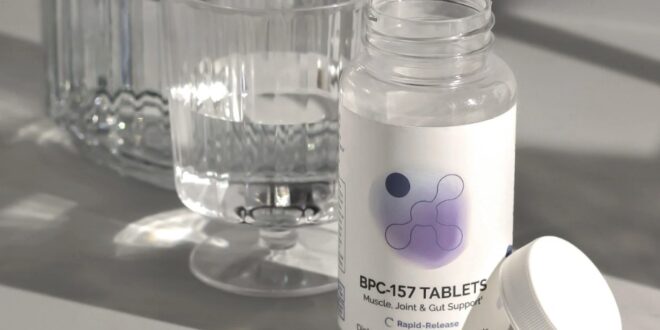Peptides have developed as a particularly fascinating field of study among the never-ending search in medicine for new and effective medicines. And among them is BPC 157.
This is a peptide that is made of 15 amino acids and is of particular interest to scientists for medical reasons. You can learn more about this peptide in this article.
The accent will be on mechanisms, possible uses, and potential alleviation from a range of ailments.
Understanding BPC 157
This peptide chain is known as Body Protecting Compound 157, and it is produced from a protein that is present in stomach acid. Primarily investigated in in vitro settings and animal models, it has demonstrated the potential to expedite the healing process.
Through a number of metabolic pathways, BPC 157 peptide mainly promotes angiogenesis, the process of the development of new blood vessels. This is very important to the healing process because this improves blood flow to injured tissues, as well as supplying vital nutrients and oxygen. This medical research has demonstrated that this amazing peptide upregulates the expression of genes related to tissue regeneration and angiogenesis.
The effectiveness of this great peptide in hastening the healing of various wounds, such as ligament injury and tendon-to-bone repair, has been shown in an experimental study conducted on rodents.
Furthermore, it has demonstrated preventive advantages for gastrointestinal health, which makes sense considering where it came from.
Therapeutic Applications of BPC 157

Since it has strong therapeutic effects, it has great potential in the field of sports medicine. Its healing properties may be advantageous for athletes who sustain injuries frequently.
Body Protecting Compoud 157 can have big impact on shortening healing durations by promoting faster tissue regeneration. In the case of sports-related injuries, this can be very helpful. Because this has an expedited return to play is frequently a priority.
According to preliminary research, BPC 157 can improve tissue healing and hasten recovery when given promptly after damage.
Orthopaedic problems like fractures and joint injuries can really benefit from this use because this is evidenced by its proven effects on tendon and bone healing in animal studies.
Although there is still a dearth of human data, the outcomes of animal models are encouraging.
BPC 157 in Digestive Health
The fact that BPC 157 was first generated from a stomach protein suggests that it has natural gastroprotective qualities. Studies show that it can greatly reduce gastrointestinal problems’ symptoms.
The capacity of BPC 157 to encourage gastrointestinal tract healing is one of its most notable qualities. It has demonstrated effectiveness in lessening ulcerative damage and quickening the gut lining’s healing processes.
It is possible that BPC 157 will help treat diseases like Crohn’s disease and irritable bowel syndrome (IBS) because of its capacity to repair and shield gastrointestinal tissues? For those who have these persistent ailments, the peptide may be a fresh source of comfort.
Safety and Regulatory Status of BPC 157

Safety Profile
As with any treatment medication, BPC 157 safety must come first. The available data, however restricted to in vitro and vivo investigations, indicates that BPC 157 exhibits a favorable safety profile, with no noteworthy side effects documented in both scenarios.
Human Trials and FDA Approval
Although BPC 157 has shown encouraging results in animal models, the FDA has not yet cleared it for clinical use.
Before it can be regarded as a practical therapy option, extensive human clinical trials must be conducted to determine its safety and effectiveness in humans.
Legal and Ethical Considerations
Legal and moral concerns are brought up by the use of peptides like BPC 157, particularly in sports. Because regulatory agencies have not approved BPC 157, it is now illegal for personal use in many jurisdictions. This is mostly because of this.
Enhancing Healing

Therapy regimens in both sports and medicine may be completely changed by BPC 157’s ability to speed tissue regeneration, which has demonstrated a great deal of promise. This peptide promotes angiogenesis, or the growth of new blood vessels, which aids in the healing process.
This procedure is essential for providing oxygen and nutrients to injured tissues, hastening the healing process.
BPC 157 may find use in human orthopedics and sports medicine, as experimental research has consistently shown that it speeds up the mending of bones and tendons in animal models.
Potential in Treating Gastrointestinal Disorders
The robust gastroprotective qualities of BPC 157 are explained by the fact that it is derived from a stomach protein. Its capacity to treat stomach irritation and repair ulcers has been well investigated.
This peptide regulates the release of several hormones and enzymes important for digestive health in addition to encouraging cellular regeneration in the gastrointestinal system.
With its therapeutic potential, it can help patients with long-term gastrointestinal diseases by treating ailments like esophagitis, gastritis, and inflammatory bowel disease.
Regulatory Hurdles and Research Pathways
Significant regulatory obstacles, such as stringent safety and efficacy assessments by organizations like the FDA, must be cleared before BPC 157 may be extensively used as a therapy option. The peptide is currently being studied clinically, mostly in animal models with some limited human studies.
The objective of this research is to determine a thorough safety profile and therapeutic efficacy that would support its application in medical settings.
To completely incorporate BPC 157 into treatment regimens, additional ethical and regulatory factors must be taken into account. This is especially important in sports, where the usage of peptides might muddy the lines between therapy and enhancement.
Conclusion ─ Assessing the Potential of BPC 157
There are many potential and obstacles in BPC 157’s path from a promising peptide in experimental settings to a widely used medicinal drug.
Even if the initial evidence seems promising, more extensive research in the form of regulatory assessments and clinical studies is required.
BPC 157 may actually provide genuine relief for a number of ailments if it is shown to be safe and effective in people, potentially altering lives and the course of healing. The medical community is keeping a close eye on the findings in the hopes of discovering a new weapon to combat illness and injuries.
 Jewel Beat
Jewel Beat

